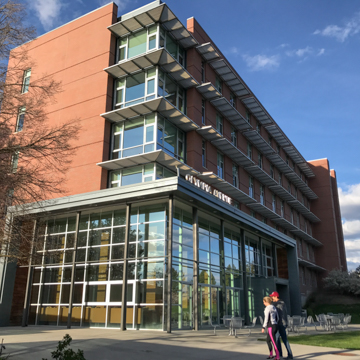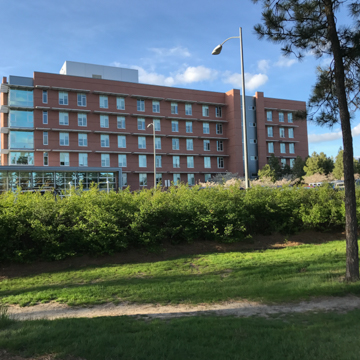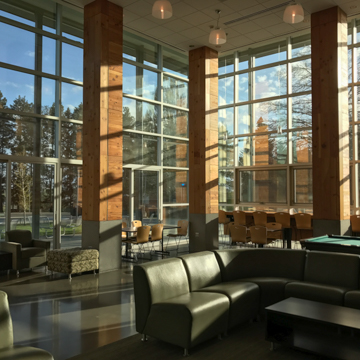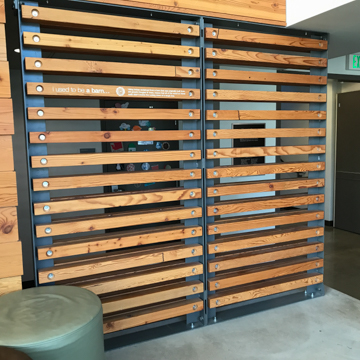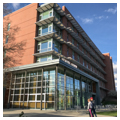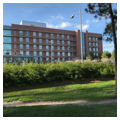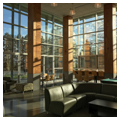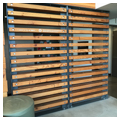You are here
Olympia Avenue Student Housing
The first residential hall to be constructed on the Washington State University campus in 37 years, Olympia Avenue Student Housing, completed in 2009, was designed and built quickly to fulfill a vital housing need due to an increasing student population. Despite an accelerated construction schedule, the 117-room, 235-resident capacity structure was erected with considerable attention to a rising culture of sustainable design—both on campus and in the Pacific Northwest more generally. The dormitory set a standard for new construction: since its completion, all new residential buildings on campus, regardless of the designer or delivery method, are designed with an eye toward energy- and water-saving features.
Designed by Seattle-based Mithun Architects, the $26 million Olympia Avenue—completed in only a year and a half—stands atop the crest of a hill overlooking the agricultural heart of campus to its north and the Rogers-Orton playfield and the Rogers and Orton residential halls to its south and west, respectively. Despite its location atop one of the highest points on campus, Olympia Avenue blends into its environment and is not immediately visible: it is anchored into a small slope, set back from Olympia Avenue road across a parking lot, and obscured by tall ponderosa pines to the south.
The 76,000-square-foot, steel-framed, six-story building’s inconspicuousness fits with its ideology: by design, Olympia Avenue was intended to showcase its natural systems and inspire a particular way of life for its mostly first-year students. To increase awareness, color-coded signage and icons explaining the building’s working systems and suggesting best practices regarding energy and waste are located on wall surfaces throughout. The building’s resource-saving features include geothermal heating and cooling, low-flow plumbing, and rainwater retention and re-use for irrigation. Olympia Avenue also employs passive strategies to retain heat in the winter and to shield residents from the summer sun. Included among these strategies and reminders of environmental features is an expansive, two-story light-filled lobby with louvres that adjust to natural light and provide shading. The lobby also includes wood paneling, reclaimed from nearby barns, which covers most of the wall surface, and it features exposed floor-to-ceiling rectangular columns echoing the verticality of the trees visible in the near distance. Large sliding-glass doors open onto a patio in warm weather; a gas fireplace, a classroom, a meeting room, and a media center are also included on the ground floor.
Olympia Avenue’s main entrance is to the south, through a glass pavilion-like structure that wraps the building on the south and west. A glass tower, rising above the pavilion on the building’s southwestern corner, demarcates each floor’s common lounge and helps bring natural light down its hallways. Four-bed, two-bed, and single-bed student rooms, with tall windows, open from double-loaded corridors. Quiet spaces for study and more active community rooms extend from these corridors—these, among other spaces (including lounges equipped with kitchens, couches, and televisions), were requested by students in a series of charrettes prior to design development. An open staircase with windows at each landing helps connect the various floors and encourages interaction—and exercise. Ron van der Veen, Mithun’s lead designer for the project, envisioned the building something like a neighborhood, where students would interact both with themselves and nature in a “healthy, sustainable living and learning environment.”
In keeping with campus tradition, the building’s facade includes red brick. But in an attempt to reduce fossil fuels, all new materials used in or on the building were obtained from manufacturers located within a 500-mile radius of campus. Many of the materials were recycled (including the polished concrete floor of the lobby); the recycling of materials apparently allowed Graham Construction, the project contractor, to achieve a 50 percent reduction in overall construction waste. Olympia Avenue earned a PCBC Gold Nugget Grand Award for “best campus housing” at its 2010 conference; the judges noted that it “sets a new standard of quality for the student campus experience.” For its environmental efforts, Olympia Avenue received the first LEED Gold certification at WSU.
Writing Credits
If SAH Archipedia has been useful to you, please consider supporting it.
SAH Archipedia tells the story of the United States through its buildings, landscapes, and cities. This freely available resource empowers the public with authoritative knowledge that deepens their understanding and appreciation of the built environment. But the Society of Architectural Historians, which created SAH Archipedia with University of Virginia Press, needs your support to maintain the high-caliber research, writing, photography, cartography, editing, design, and programming that make SAH Archipedia a trusted online resource available to all who value the history of place, heritage tourism, and learning.




















